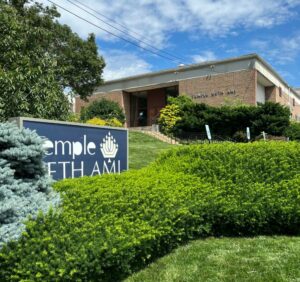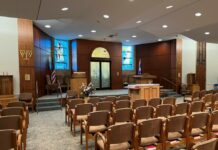
When Barry Stucker arrived at Temple Beth Ami in 1970, he found a bustling community. Founded in 1955 in Northeast Philadelphia by World War II veterans and other Jews who were starting families, the shul grew from a group of neighbors to a crowd of about 500 people on High Holidays.
It also grew from meetings in living rooms to a property, on Old Bustleton Avenue, with a sanctuary, a Hebrew school and a day care. What was once a havurah was now a modern synagogue.
Stucker, then 23, joined with his parents and two brothers after they moved from North Philadelphia to the Northeast. But Stucker is the only one left. His parents and brothers are sadly “long gone,” he said.
And they are not the only people who have passed on or moved out of the area, according to Stucker. The synagogue’s president, now 76, leads a community with about 150 members left. Maybe 25 more show up for High Holidays. There is no more Hebrew school or day care. There are no kids to fill those spaces.
“We’re mostly older,” Stucker said.
But still here.
Every Shabbos morning at 9:30, there’s a service. About 30 people attend each week. If there’s a special event, 45-50 people may show up.
Once a month, a part-time rabbi, Mitchell Novitsky, leads the service. When Novitsky is not present, Stucker becomes the rabbi.
“We’ve had some bad weather. Heavy rains. I praise the people in attendance. ‘You’re very hearty. You’re dependable. Everyone here should appreciate all the others who are here,’” the president said.
Membership may be declining, but Temple Beth Ami’s service remains the same, according to Stucker. It’s traditional. Most of it is in Hebrew. It features more prayers that “go back thousands of years” than you might see in a less traditional service, Stucker said.
“It’s a part of our heritage and I feel when some synagogues omit them or they truncate it, they are losing something,” he added. “And once they’re gone, it’s kind of hard to start up.”
Temple Beth Ami’s founders are deceased. Its membership base consists of Jews who have stuck around in the neighborhood through a period of demographic change. The small number of young congregants who are involved drive in from suburbs about 30-40 minutes away.
There was once a large board of directors that included representatives from the various synagogue organizations like the sisterhood, the men’s club and the parent-teacher association. They were all at the table. Now, none of the groups exist.
Fortunately, Temple Beth Ami’s building is so old that it’s already paid off. Therefore, there are not many expenses for Stucker to stress over. And the few that remain can be covered by dues and a rental agreement with the nearby Politz Hebrew Academy. The Orthodox school rents space for an after-school program during the year and for its camp, Achdus, during the summer months.
“When we get a bill, it’s paid off that week for the following week. We try to keep the expenses as low as reasonably possible,” Stucker said. “In the winter when it’s cold out for heating the building. And in the summer for air conditioning.”
The president does not have to remain so deeply committed to his shul. He just likes it.
“Temple Beth Ami from when we joined until now was a welcoming shul,” he said.
And he tries to keep that tradition alive. When visitors walk in, he approaches them, asks if they’re from the area and how long they plan on staying.
Temple Beth Ami’s payment structure is just as welcoming. It’s give-what-you-can. And if you can’t, that’s fine, too. Most people still pay.
“We don’t turn anyone down,” Stucker said.






